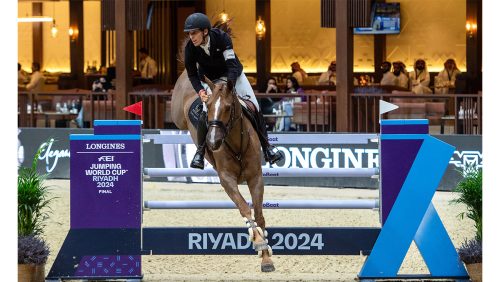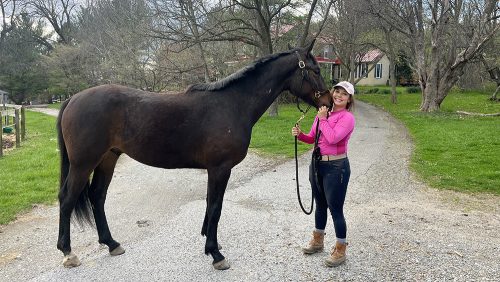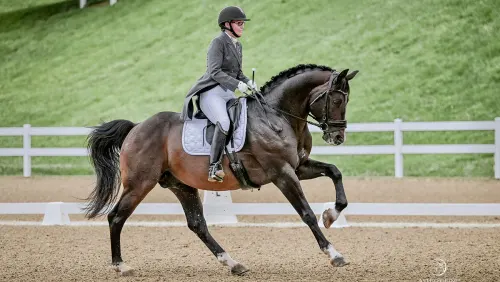And how the simplest exercises are sometimes the most profound.
My teacher Dietrich von Hopffgarten once told me the best test of judging a ride would be to imagine a piece of yarn attached between the bit and the rein. Would the rein still be attached at the end of your ride?
He believed this to be one of the best tests of correct contact and lightness. Now don’t get me wrong, he was realistic that training takes place when the actual tension in the rein would easily break the string, but that moment in training, that purposeful need to have the contact more taut, is only for a specific time or movement. That aside, on a good day, when all is well, if you were just to ride through what you and your horse are working and schooling with regular consistency, would you have the ease and lightness to pass the test?
Years ago, when I was about 16, we were watching the Olympics on the old farm VCR in the living room of the working students’ home where Dietrich had lunch every day. He kept mentioning how strong and manhandled some of the horses looked.
He said if he could, he’d take the top five horses from that competition, tie yarn onto their bits, have them ride, and whoever had the reins still attached at the end of five minutes would get the medals. They didn’t even need to ride through their Grand Prix program, they just needed to ride for five minutes.
It’s really interesting to revisit the idea of the string test, the concept of lightness, what contact truly means and, at the heart of it, true collection.
Confusion About Collection
A few years ago, in an interview, I heard a famous U.S. trainer, who is notorious for only riding horses in double bridles and only working in a snaffle bridle with draw reins, say that in this day and age, with the movement we have bred into our dressage horses, it’s nearly impossible to train a horse to Grand Prix with a snaffle alone. This trainer went on to say they give major credit to anyone who can, in fact, do that, as they can not.
That comment really does seem foolish and uneducated on many levels, especially considering the quality of rider this person is supposed to be. If we are in fact breeding far superior horses now, why are they not also superiorly lighter and softer? Does movement alone contribute to weight in the bridle with no involvement of conformation or temperament, not to mention training?
Also, if we’re breeding such superior horses with a movement quality that far outweighs and performs all predecessors, why is it that they would be moving in a way that is stronger in the hand than the clunkier and heavier counterparts of years past?
Should we really blame the breeders for producing lighter, more elegant, better moving horses with hard mouths or with hind legs that overpower their ability to balance? If so, are those really superior horses, or in fact, do we even want those horses as riding horses?
This makes no sense. It seems more likely that this trainer really doesn’t understand what it is to have a horse “through” and on the hind legs, meaning soft and actually collected.
I often ask my students what collection means to them and how is it achieved. The myriad of responses would leave one who’s not savvy enough to sort through them all strangely lost in a bombardment of terms and ideas much like a dog that hears a noise it can’t quite compute, with its head turned to the side.
ADVERTISEMENT
Instead of simply saying it’s the shifting of the horse’s mass and forehand backward onto his hind legs, and it’s the weight shift that defines the collection, they come up with the craziest ideas, reminding me of the old show “Kids Say The Darndest Things,” except that it’s not just children.
If you really understand the concept of collection, you understand that with training, the horse becomes lighter, not just lighter on the forehand, but also lighter in the hand. Our goal in training is to make the horses lighter, more sensitive and maneuverable, not heavier. If we understand that collection creates lightness, the collection is correct. When the collection places a horse more on the forehand or more heavily loaded into the bridle, that collection is false.
If our training creates a horse who cannot be ridden on a snaffle bridle, our training is wrong. Think of sitting on a teeter totter or seesaw right in the middle at the fulcrum where the teeter totter is horizontal to the ground. Now place a 10-pound bowling ball on the far end of the teeter totter in front of you, and attach ropes to the far end, to work like reins, so that while you are sitting in the middle, you can hold up the front end so the balance remains absolutely horizontal, with the weight of the bowling ball pulling the ropes downward, but at a manageable level. At that point, think of the amount of weight you’d have in the rein in order to hold it horizontal. Now have a friend walk behind you and start to push down on the end behind you so that the end in front of you starts to rise up. At this stage, two things happen: 1) The load in front becomes lighter to hold up as you have help, through the force pushing down the back end; and 2) The bowling ball on the front end of the teeter totter starts to slide backward toward your lap.
Now think of the rope as reins, the board of the teeter totter as the horse’s body, and the 10-pound bowling ball as your horse’s center of gravity. Beyond that, if you could imagine that within that shift of balance and therefore transfer of weight, it becomes increasingly easy to get the back end down and the front end up, you now understand collection.
If we understand that this lightening of the forehand and shifting of weight onto the hindquarters is collection and then in turn see the way the reins would become lighter, why wouldn’t a horse be easier to ride in the mouth with training when the collection is correct?
The proof of correct collection isn’t only lightness of the forehand but also a lighter contact in the reins. This is why we see so many older etchings and paintings with riders riding with the reins in one hand, both on snaffle and/or curb alone. Often the whip is turned upside down showing how little it’s needed once the coil of collection has taken shape.
The Spanish Riding program has horses who are not as designed for extravagant movement or lightness of the forehand as are our modern “superior” horses, yet they still ride and train daily on snaffles, not only doing the Grand Prix work, but also airs above the ground far surpassing our show horses in weight loading of their hind legs.
Yet these riders can do “high-school” level work, in hand or on long lines, on snaffle bridles or doubles, and not be run over, trampled, drug, pulled off their feet or worse, out of the saddle, and do not need stronger bits and tighter nosebands to resolve the issue.
Learn From The Past
Many books have been written on how to train the most basic concepts like trot-halt transitions, what to look for when doing them, how early to start them and how demanding to be. As early as the Duke of Newcastle one sees the use of trot-halt transitions to teach the horse to lower his hips, tilt his pelvis, weight load his hind legs, and in turn learn the most basic principles of collection, which can happen or at least begin to happen very early in the horse’s education.
The Duke of Newcastle said, “The whole object of the ménage (school) horse is to get the horse upon the haunches, and the best exercise I know is to trot and halt.” It seems there was, and still is, the understanding of how to put a horse on the haunches through simple work, but those approaches often go unread or unused.
There was a video floating around of Ingrid Klimke on one of her horses with an absolutely beautiful, well-executed, nearly perfect weight loading halt right at the beginning. The video went on to talk about the halt, the aids, the use of the half-halt and so on, but strangely the halt she did didn’t seem to get as much emphasis. It was turned into more of a Facebook “soundbite” that people share, repost, comment on, but don’t really take the time to study. If everyone is posting and forwarding it, why does it go unnoticed that we so seldom use such an exercise in our everyday work? Is it only because Ingrid is so good, and we think she knows things we don’t and employs them in her training when no one is looking, so that particular halt was great, but not something we think actually shapes her training?
We keep historic records on all kinds of subjects so future generations can learn from the mistakes of their predecessors. If people went through so much trouble to write down what they’ve learned and the struggles they’ve been through, we’re foolish for not taking more advantage of these tools. Nevertheless, if you are not a reader, these will always be lost on you; if they don’t get read, they don’t get used.
ADVERTISEMENT
Prove It
Back in the days of the VCR, 8mm video and well before the internet, my teacher used to talk about old German national level tests that required riding medium trots and the like with the reins in one hand to prove self-carriage and lightness, correct understanding of contact and thoroughness. He practiced this often and taught it in his lessons.
In this day and age, how often, other than the occasional clever rider in a freestyle, do you see people work with the reins in one hand to prove their training or test their horse’s self-carriage, understanding of contact and throughness?
How often do you see riders who aren’t on the centerline or at the required letter or location in the arena schooling halts that aren’t just about getting better scores on them? One of the oldest and most traditional exercises for teaching half-halts and training horses to sit starts with this elementary work that gets ignored for flashier work, only schooling with a test in mind.
It’s funny how often we forget to school this most basic concept in getting a horse to understand how to lower its hips and tilt its pelvis. It is probably the best half-halt reminder on our horses, since if we school them regularly and become increasingly demanding on the correctness and obedience, the horses begin to somewhat anticipate the act of the halt. This creates a half-halt as an anticipatory body posturing the horse takes on when feeling the rider begin to apply the halt aids.
Tried And True Transitions
That said, if you’re thinking in terms of using things like halts to improve lightness and collection, you’re understanding that there is in fact a difference between throughness and suppleness. Not that a horse isn’t sometimes described as being longitudinally supple, but really, any suppleness in regard to the horse’s topline being round, soft, the back being lifted, on the bit without resistance and so on, is really speaking to the throughness.
Suppleness is all about the horse’s body being free of resistance and flexible, which is mostly achieved via bending exercises and lateral work, whereas our throughness and longitudinal work is done on exactly that, the longitudinal axis, being transition work, half-halts and changes within the gait. As a general rule, transitions create throughness and bending work our suppleness.
When we talk about the horses being light, shifting into greater degrees of collection, becoming more through and so on, having a “light” mouth or contact and feeling good in the bridle, we look to the transition work as our greatest help in that struggle.
It’s not possible to supple a horse off the forehand, but it is possible to transition them so. Yet far too often we see riders give up collection work in order to create lightness for more and more suppleness and bending work, in turn, fixating on the mouth and neck of the horse and hand of the rider to resolve what is usually a fairly simple issue that physics and science can solve for us if we understand weight shift, pendulums, leverage, gravity, inertia and momentum.
So if we know how the physics work to get a horse lighter in the hand, why would we blame the breeders for creating horses who are moving so big they are too strong to train to be light in a snaffle?
Jeremy Steinberg was the U.S. Equestrian Federation Youth Coach from 2010-2014. He’s a well-known rider, trainer and competitor based out of Del Mar, Calif. He is one of four clinicians who works with the U.S. Dressage Federation in its Platinum Performance/USDF junior and young rider clinic series. He worked with long-time friend and mentor Dietrich von Hopffgarten extensively until his passing in 2004. Jeremy has trained and shown through the Grand Prix level. He now runs a small “boutique”-type training business and travels the country giving clinics. More information can be found at steinbergdressage.com.















